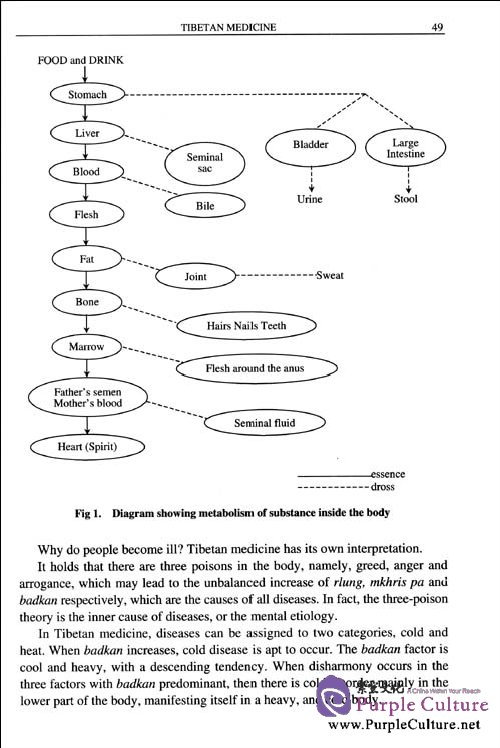Sample Pages Preview

1.2.3 Etiological Theory
Formed
when Buddhism first flourished, Tibetan medicine is unique in
itsrecognition of the causes of disease, with an ethnic flavor, as well
as a religiouscoloring, thus forming a unique theory of etiology. There
are several methods of classification. A theory holds that diseases
occur only under three conditions, ieorig in, accumulation and
induction. This is called the theory of external causes. On the origin,
it is claimed that the seasons, the five sensory organs, anddaily life
are closely related. Any reverse, deficiency, exuberance of an
elementcan become the origin of a disease. For instance, season refers
to cold, heat and rain. When these three are less than normal, then this
is a deficiency; when they are in surplus, then, it is excess. Opposite
refers to heat appearing in the coldseason, cold appearing in the hot
season, and drought appearing in the rainyseason; these are all
opposites. Or, in other words, they are the origin of diseases. This is
quite similar to the six-excessiveness theory of etiology in TCM. The
five sensory organs are responsible for special sensation, namely,
theeyes for seeing, the ears for hearing, the nose for smelling and the
tongue fortasting. When stimuli are optimal, then, no disease would
happen. Any deficientor excessive stimulus m either too far, too near,
over-stimulation or in aparadoxical form that cannot be tolerated by the
organism forms a reverse
PrefaceTraditional Tibetan
medicine is a time-honored medical knowledge systemcreated mainly by the
people inhabiting the Himalaya Mountains and the QinghalTibet Plateau
region through a long course of experience in fighting againstdisease
and preserving good health. Naturally, the provenance of Tibetan
medi-cine should originate from Tibet, but Tibetan medicine is also an
integral part oftraditional Chinese medicine (TCM) as a whole.
Ironically, due to complex historical reasons, for a long time, Tibetan
medicine didn't arouse due attentionand interest in inland China. Before
1949, no works on Tibetan medicine hadappeared in China, and there were
no academic papers published either. Over the last three decades,
people in China, including the Tibetans them-selves, have begun to pay
close attention to Tibetan medicine. A number ofhigh-quality academic
papers have been published, some of them exerting greatinfluence in the
pertinent fields, arousing interest among all of those closely involved
in the field of Tibetology. The Sman thang Series of hanging scrolls
with amedical theme, for instance, was first published in China in the
mid-1980s inboth Tibetan-Chinese and Tibetan-English versions, marking a
new epoch in the study of Tibetan medicine in China. Of course, due to
the lack of experience and constraints at the academic level, these
publications are certainly not perfect. Yet, the project plays a
pioneering role in expediting the pace of China's efforts tocatch up
with the study in this field internationally.
